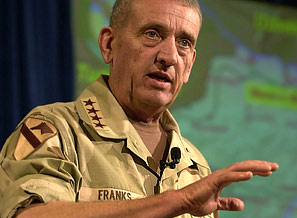Head of U.S. Central Command during the 2003 Iraq War
As the head of U.S. Central Command during the 2003 Iraq War, General Tommy Franks directed the military effort that led to the fall of Saddam Hussein’s government. Franks had first come to public attention two years earlier, as the head of the successful U.S. military invasion of Afghanistan. Although rumors circulated that the general clashed with U.S. secretary of defense Donald Rumsfeld, the men worked together to plan two successful military campaigns.
Tommy Ray Franks was born in Wynnewood, Oklahoma, on June 17, 1945. He grew up in Midland, Texas, and attended the same high school as President George W. Bush and his wife, Laura. Upon graduating in 1963, Franks studied business administration at the University of Texas at Austin. Two years later, he joined the U.S. Army to fight in the Vietnam War.
After completing military training, Franks received the rank of second lieutenant and was sent to Vietnam in 1967. He served as a forward observer in the Ninth Infantry Division and was wounded in combat three times. Upon his return to the United States in 1968, Franks was stationed at Fort Sill in Oklahoma. He married Cathryn Carley the following year.
Franks received further military training and also completed his bachelor’s degree in 1971. In 1976 he was assigned to the Pentagon, where he served in the office of the army chief of staff for five years. In 1981 he was stationed in West Germany, where he commanded a battalion for the next three years. Upon returning to the United States in 1984, Franks attended the U.S. Army War College. He also earned his master’s degree at Shippensburg University.
After Iraq invaded the neighboring country of Kuwait in August 1990, Franks was sent to the Persian Gulf during the military buildup known as Operation Desert Shield. He served as the assistant commander of the First Cavalry Division during Operation Desert Storm, in which the U.S.-led coalition pushed the Iraqi army out of Kuwait. Franks continued his service to the army in a number of capacities following the 1991 Persian Gulf War. He was promoted to lieutenant general in 1997. In July 2000 Franks was named commander in chief of U.S. Central Command (CENTCOM). Headquartered in Tampa, Florida, CENTCOM was responsible for directing U.S. military operations in the Middle East. A few months later, radical Islamic terrorists launched a suicide bombing attack against the USS Cole, an American destroyer anchored at a port in Yemen. The attack killed seventeen U.S. Navy sailors.
The terrorists dealt the United States an even more devastating blow on September 11, 2001, when attacks on the World Trade Center towers in New York City and the Pentagon building near Washington, D.C., took the lives of nearly three thousand people. Immediately after the attacks, President George W. Bush launched a global war against terrorism. The first target of this war was Al Qaeda, the terrorist group responsible for the September 11 attacks, and its protectors in Afghanistan.
As the head of CENTCOM, Franks acted as the commander of U.S. military forces during the war in Afghanistan. The war succeeded in destroying Al Qaeda training facilities and removing the Afghan government that had sheltered the terrorists. But many Al Qaeda leaders remained at large in the rugged mountains of Afghanistan. “While an awful lot has been done in Afghanistan,” Franks told the Associated Press a year after the military operations there ended, “We’re just going to have to stay with it for as long as it takes.…”
In 2002 Bush expanded the war on terrorism to include countries that he described as threats to world security. The president claimed that Iraq possessed weapons of mass destruction and could provide such weapons to terrorist groups. He argued that military action was necessary to disarm Iraq and remove Saddam Hussein from power. As the United States moved toward war, Franks was assigned to help plan the American invasion of Iraq.
Some Pentagon officials described the planning sessions as being filled with tension between Franks and Secretary of Defense Donald Rumsfeld. They claimed that Franks resented Rumsfeld’s heavy involvement in determining the military strategy. They also said that Franks resisted Rumsfeld’s demands for a light, mobile invasion force that could advance rapidly toward Baghdad. But Rumsfeld insisted that Franks was responsible for drawing up the war plan. The secretary also gave Franks credit for changing the plan as needed to adjust to the actual situations the troops encountered.
The 2003 Iraq War succeeded in capturing Baghdad and removing Hussein from power after only a few weeks of fighting. Franks received a great deal of praise for the successful U.S. strategy, which kept American casualties to a minimum. In May 2003, just a few weeks after major combat operations ended, Franks announced his intention to retire from active military service. Rumsfeld offered him the position of army chief of staff, the highest position in the army, but Franks declined. The general later signed a contract with HarperCollins to write his memoirs.
